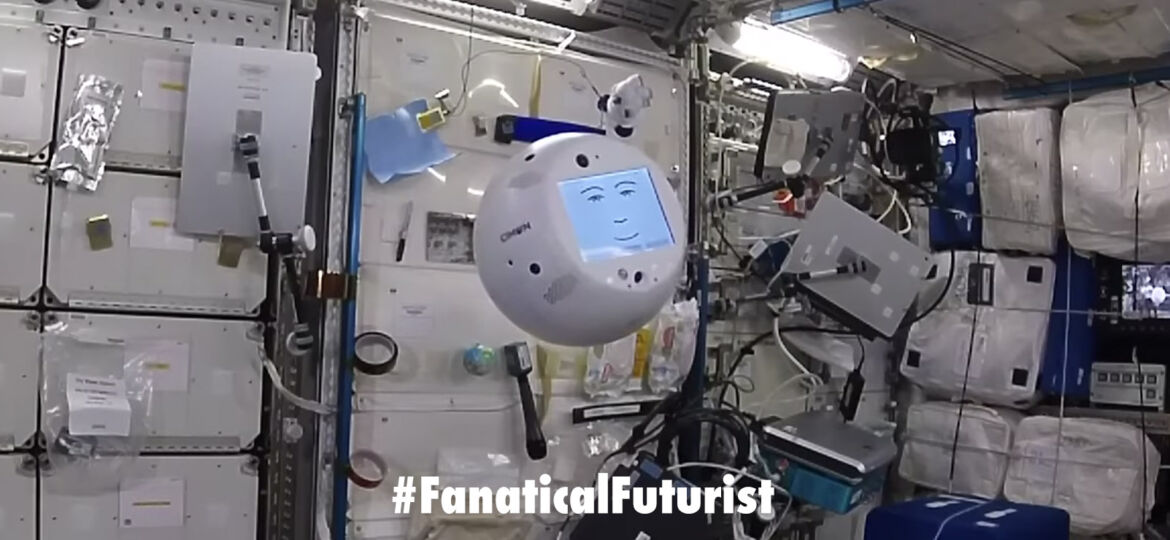
WHY THIS MATTERS IN BRIEF
As more machines and humans work alongside one another how we interact with one another will become increasingly crucial.
As he entered his final month on the International Space Station (ISS) on Monday, Alexander Gerst could be proud that he’s helped given birth to a healthy, if moody, robot companion that will be the first of many floating about the space station helping astronauts perform their duties better, and keeping them entertained.
Gerst, a German astronaut and geophysicist for the European Space Agency, or ESA, is commander of the space station’s 57th mission, and he’s in charge of fellow astronauts, including two from NASA, and an 11 pound 3D printed plastic ball infused with a “quirky” personality named CIMON, short for Crew Interactive MObile CompanioN, that joined him and his crewmates on the ISS just over a month ago.
Such an attitude (3:10)
CIMON, which was built by Airbus for the German Space Agency and runs a version of IBM Watson’s Artificial Intelligence (AI) agent, has a video screen face, a video camera and a digital voice so it can talk with the astronauts. Eventually CIMON will be used to automatically display and explain all of the information needed to help the astronauts on the station carry out essential experiments and repairs, but during his early years of operation CIMON’s main purpose is simply “to become Gerst’s friend.” And as is often the case, friends can be a little tetchy, as Gerst kept finding out.
When CIMON first arrived on the ISS for its first test run it responded to the command “Wake up, CIMON,” by asking, in what can only be described as a chirpy drone, “What can I do for you?”
In a video published Friday by the European Space Agency and posted to Gerst’s Twitter account, on its first run CIMON successfully recognises Gerst’s face, turns 90 degrees on command and helps Gerst with an experiment.
“Straight out of a sci-fi movie? Not yet, but a successful first technology demonstration of a DLR [German Aerospace Center] experiment, designed to test what future human-robot interaction might look like in space. And CIMON even plays Kraftwerk on command!” comments Gerst.
That last observation refers to CIMON’s dialing up “The Man Machine,” from the album of the same name by the German electronic music pioneers Kraftwerk, when Gerst asks it to play his favourite song. Then things start getting interesting.
CIMON properly acknowledges Gerst’s commands to stop playing music and to start taking video with its front camera. But then says, “Let’s sing along with those favourite hits.”
When Gerst orders it again to stop playing music, CIMON, sounding somewhat petulant, replies: “I love music you can dance to. All right. Favourite hits incoming.”
Gerst tries again to stop CIMON from spinning up records, to which it replies: “I understood you like the music. I understand that.”
Gerst explains to a colleague that while CIMON is properly playing the requested video stream, it’s not only “still talking about music but it’s also stubbornly floating back to a position in the cabin that it appears to prefer.”
“He appears to like the deck position better,” Gerst says, in what apparently is the straw that broke the robot’s back.
“Be nice, please,” CIMON says in a softer voice. A moment later, it asks, “Don’t you like it here with me?”
“Don’t be so mean, please,” it says, before observing, in a fashion eerily reminiscent of the HAL 9000 computer in 2001: A Space Oddysey, “Oh, dear, I feel you. I can already hear your stomach roaring. Should we take a look for when it is time for food?”
Gerst remarks that CIMON is “a little bit sensitive today” before shutting down the test run.
A goal of CIMON’s creators is for it to show some personality, and Gerst concludes, “That’s really a great demonstration.”
ESA agreed, saying in a blog post that “CIMON’s developers and Alexander hope to see CIMON back in action again soon.”
“While no further sessions are planned during the Horizons mission for the time being, it could mark the beginning of exciting collaboration between astronauts, robotic assistants and possible future artificial intelligence in space,” the agency said.
And as for what the future holds for CIMON? Well, he’ll be back online soon for more test runs, likely be spinning up more tunes and quips, and who knows, one day he might even be running the show – although hopefully not because, like HAL 9000, he killed them all by turning their oxygen off because he thought it would get him more laughs.
















